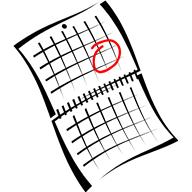Back in my journalism school days, the press release was all about the who, what, when, where, why and how of the topic. Not much has changed in that regard; your press release should definitely cover those critical elements. However, you have to begin by knowing the purpose of your press release.
Here are a few common reasons to write a press release:
Book launch. You’re announcing to the world – well, at least the world that includes your ideal readers – that your book is complete, published and ready to purchase.
Current event. The focus and
content of your book relates to a current event; something that is hot in the
news right now. Here's one recent example of a press release I wrote for my client, Pat Montgomery, author of The Patriot Parent: Still the Best Hope for America.
Local. You want to tie in your
connection to your home town, your current city of residence, your alma mater,
the city where you’re speaking or some other localized event.
Okay, so now that you know some
angles to use in creating a press release, you need to make certain that you
include all of the pertinent items that a reporter, assignment editor or
blogger needs to know. You might think it doesn’t matter one way or the other
how your press release is organized and presented, but it does. If for no other
reason than to communicate your message clearly and effectively, you will want
to include all of the following elements in your press release:
For immediate release: This lets reporters know that they can upload or print the release immediately and not have to await some specific date.
Contact information: List
the name, phone number and email address of the person reporters can contact for
more information or to schedule an interview with you. It’s always nice if this
is someone other than you, the author. Which is why it’s good to work with a
professional in public relations, marketing or media relations.
Headline: Grab
their attention and be descriptive. Keep it brief. Five to seven words is
plenty.
Dateline: Use
the date you actually send the release.
Newsworthy: Make
it timely and relevant. Even if your press release is announcing the launch of
your book, you want to tie it to something current and relevant. Why should
people care about this, and why now?
Remember the five Ws: Be
sure to creatively mention these critical elements of your announcement.
- Who are you and who is the book written for?
- What is the book about (in just a few sentences)? What can readers learn from the book?
- When did it come out (last
week, last month, last year)? Even older books can get some play when you tie
the theme of the book to a current event or observance.
- Where can people buy the book,
learn more about you or get more information? Where will you be speaking or
signing your book?
- Why did you write the book?
Make it about the reader, not about you.
- How can people contact you?
How can readers use the content in your book to improve their lives?
Statistics: If
appropriate to your book’s theme and content, include a few stats to help
drive home the importance of your book or issue.
drive home the importance of your book or issue.
Interactive:
Include hyperlinks in the body of the press release (your website, book
excerpts, videos, book trailer, previous interviews or articles).
Call to action: Much
like an advertisement, your press release is an opportunity to tell people what
action you want them to take. Don’t make it salesy. Keep it simple (i.e. visit
the website for more information, sign up for the newsletter to receive the
free report, call to reserve your space).
As you write this phenomenal press release, try to think like a reporter. Write what
readers/listeners/viewers need to know, not only what you want to say. Write the release as if the editor or reporter will drop your press release into the publication as is. Don’t assume they will change anything, which means you want the release to be as accurate and effective as possible.
Here are a few common questions I'm often asked about press releases:
How long should my press
release be? Keep it between 400-500 words; not much, but that should
cause you to write lean and get to the point.
Should I attach or include a
photo? Photos fill up a person’s email in box. At the end of your
press release, add a note: Photo available upon request. Mentioning this is a
great way to get a reply from interested journalists.
Who do I send the press release
to? Much of this depends on the focus on your release and your book.
Here are a few common titles to look for:
- Print: Book Reviewer, Community Affairs Reporter, Business Reporter/Editor, Lifestyle Reporter, Parenting/Family Reporter.
- Broadcast: Assignment Editor, Community Affairs Reporter.
How do I know if my press
release was featured? Reporters will not advise you that your press release was
picked up. So sign up for Google Alerts
to make sure you know that your release appeard online. Or search “news
clipping service” to find free and fee-based services to monitor and track your
news online and offline.
Have a question about your press release? Submit your question below.
_____________________








